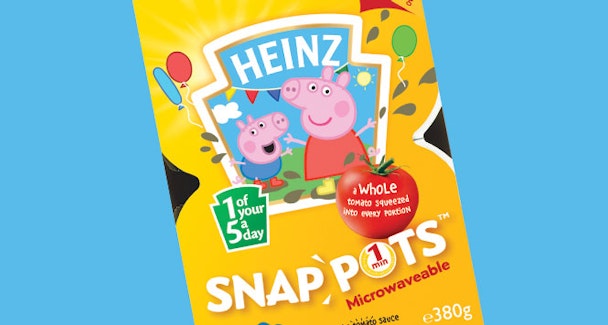Health groups to UK government: 'stop brands using cartoons to market junk food to kids’
Pressure is mounting on the UK government to prevent food brands such as Heinz from using popular cartoon characters from TV and film to market junk food to kids.

Characters from Peppa Ping and Paw Patrol were named as the worst cartoon offenders
Action on Sugar and Action on Salt has called for a ban on on-pack cartoon animations on food that is high in sugar and salt to stop manufactures “deliberately manipulating” children and parents. The groups also want to mandate ‘traffic light’ nutrition labelling, giving parents the chance to make healthier choices.
The lobbying organisations conducted a study, in tandem with the Children’s Food Campaign, which found that 51% of food and drink products which use cartoon animations on-pack to appeal to ids were unnecessarily high in fat, saturated sugar and salt.
Of the 500 products the study examined, from brands like Heinz, 21% used licensed characters – including cartoons from Disney’s Frozen and animations from Peppa Pig. More than a third of these (37%) were found to be confectionary, cakes or ice-cream, while 34% of products featuring licenced characters were deemed ‘red label’ when it came to fat, saturated fat or salt.
Characters from Peppa Ping and Paw Patrol were named as the worst cartoon offenders, with more than half of the products fronted by characters from these shows containing extremely high levels of fat, salt and sugar.
The groups claimed that if children’s packaging to follow the same advertising codes as set by the Committee for Advertising Practices (CAP) for broadcast advertising (which restrict the advertising of high-fat, high-sugar foods during children's TV programmes or any programme where 75% of the audience will be children) then half would fail the eligibility criteria and would not be allowed to be advertised to audiences under the age of 16 .
Action on Salt, Action on Sugar and Children’s Food Campaign call for this criteria to be extended to all forms of media , and to any programme watched by a child, as is currently being discussed in the Governments’ latest consultation on further advertising restrictions for products high in fat, salt and sugar.
CAP and its sister organisation, the Advertising Standards Authority (ASA), introduced new rules in 2017 for food and drinks high in fat, sugar and salt aimed at children. It is currently reviewing the effectiveness of these, along with its broadcast guidelines.
Increasing pressure
The report from Action on Sugar and Action on Salt comes amid increasing pressure on advertisers and politicians to better police how unhealthy foods are being marketed towards kids.
Late last year, London Mayor Sadiq Khan announced a ban on junk food advertising from appearing across the Transport for London (TfL) network, despite claims from the Advertising Association that there was “no clear evidence” the move would solve the UK’s childhood obesity problem.
Elsewhere, the UK government has toyed with banning ads for unhealthy foods from YouTube and Facebook, as well as before the 9pm watershed on TV. It’s currently in a public consultation on the matter.
Opposition party Labour, meanwhile, has been taking aim at the cereal industry’s use of cartoon image to attract the attention of kids, urging the advertising industry to get its house in order or expect stricter regulation should Labour take power.
Commenting on the mascot issue, Sonia Pombo, campaign lead at Action on Salt based at Queen Mary University of London said: “Parents want to make healthy choices for their children, but companies are not making this easy for them.
“The food industry has a moral duty to stop putting profits first and sell their products responsibly. There is plenty of opportunity for companies to either reformulate and make their products healthier, or make their already healthier products more appealing to children.
“Until then, the government must intervene and ensure all food and drink manufacturers at least display ‘traffic light’ labelling so parents can see, at a glance, what is in the food.”

